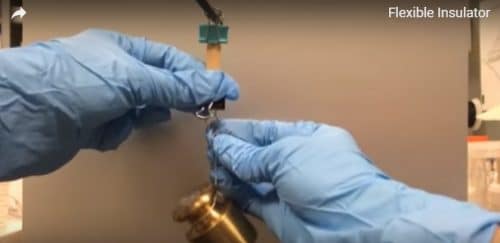In the past, researchers have succeeded in creating self-repairing materials that are able to restore a certain function from their function after being torn, however, the restoration of all functions is essential to create wearable electronic components that will also be efficient

[Translation by Dr. Nachmani Moshe]
An innovative electronic material is able to automatically renew all its functions, even after being torn several times. The material could improve the stability of wearable and flexible electronic devices.
Electronic materials constitute a major setback in the development of flexible electronic devices since existing materials do not function properly after being torn and repaired again. "Wearable and bendable electronic devices are exposed to mechanical deformations during their lifetime, deformations that can destroy or break them," says Qing Wang, professor of materials science and engineering at Penn State. "We wanted to find an electronic material that could repair itself so that all its functions would be restored, even after being torn many times." Self-repairing materials are materials that are able to repair themselves naturally, without any external influence, after physical deformation such as cutting it in half.
In the past, researchers have succeeded in creating materials that repair themselves and that are able to restore a certain function from their function after being torn, however, the restoration of all functions is essential to create wearable electronic components that will also be efficient. For example, if an insulating material maintains its electrical resistance property after self-repair but is unable to maintain its thermal conductivity property, then there will be a risk of overheating of the components. The material that the researchers created succeeds in reproducing the properties required for its activity as an insulating material in wearable electronic components - mechanical strength, breaking strength against pressures, electrical resistance, thermal conductivity and insulating properties. The research findings were published a long time ago in the scientific journal Advanced Functional Materials.
Most materials capable of repairing themselves are soft or rubber-like materials, the researcher said, but their new material is very tough. The researchers added boron nitride nanosheets to a base material made of a plastic polymer. Like the material graphene, boron nitride nanosheets are two-dimensional, but instead of conducting electricity as graphene does, they are insulating.
"Most of the research on self-repairing electronic materials has focused on electrical conductivity while ignoring the electrical insulation feature," said the lead researcher. "Indeed, we are required for conductive components in electrical circuits, but we are also required for insulating components." The material is able to repair itself thanks to the fact that the boron nitride nanosheets are connected to each other through hydrogen bonds. When two sheets come closer to each other, the natural electrostatic attraction between them brings them together even more. When the hydrogen bonds are restored, the two sheets are restored. Depending on the concentration of the boron nitride nanosheets added to the polymer, this self-repair feature may require the use of heat or pressure to activate it, however – some forms of the new material can do this even at room temperature simply by bringing the two pieces together. Unlike other self-repairing hydrogen bond-based materials, boron nitride nanosheets are impermeable to moisture. This means that the devices that use such insulating materials will be able to operate effectively even in areas with high humidity, for example - showers, pools and beaches. "This is the first time that a self-repairing material is able to restore all the many properties inherent in it even after being torn several times, an important property that can be used in a wide variety of applications," said the lead researcher.

One response
It is interesting to see if it is possible to use the hydrogen bonding properties of boron-hydride with aromatic rings (about which Dr. Nachmani wrote on 27.3.2016/XNUMX/XNUMX) instead of the hard boron-nitride that appears here: these two substances are isolated, but boron-hydrogen that binds to aromatic rings is much more flexible…